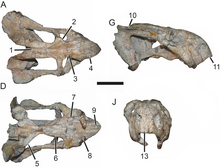Tropidostoma
| Tropidostoma | |
|---|---|

| |
| Tropidostoma dubium (SAM-PK-K11238) in (A) dorsal, (D) ventral, (G) right lateral, and (J) anterior views. Bulbasaurus phylloxyron (CGP/1/938) in (B) dorsal, (E) ventral, (H) right lateral, and (K) anterior views. Specimen has suffered some lateral compression. Scale bars equal 5 cm. | |
| Scientific classification | |
| Domain: | Eukaryota |
| Kingdom: | Animalia |
| Phylum: | Chordata |
| Clade: | Synapsida |
| Clade: | Therapsida |
| Suborder: | †Anomodontia |
| Clade: | †Dicynodontia |
| Family: | †Oudenodontidae |
| Genus: | †Tropidostoma Owen, 1876 |
| Species: | †T. dunnii
|
| Binomial name | |
| †Tropidostoma dunnii Seeley, 1876
| |
| Synonyms | |
| |
Tropidostoma is a medium-sized herbivorous oudenodontid dicynodont therapsid that lived during the Late Permian (Lopingian) period in South Africa. The first Tropidostoma fossil was described by Harry Govier Seeley in 1889. Later two subspecies were identified. Tropidostoma fossils are an index fossil in a biozone of the Karoo Basin known as the Tropidostoma Assemblage Zone. This biozone is characterized by the presence of this species in association with another dicynodont species, Endothiodon uniseries.[1]
History of discovery[edit]
The first Tropidostoma fossil material was found during a field expedition in the Upper Permian-aged Teekloof Formation of the Beaufort Group. This material was later described by Seeley (1889) in a study in which he described two fossils which had been named Dicynodon microtrema and Tropidostoma dunni. In 1915, several years after Seeley's death, the paleontologist, Robert Broom, reexamined the same material and discovered that the fossil material in question was of the same species. This new single species was renamed Tropidostoma microtrema.[2] Some years later, the name T. microtrema was changed to Tropidostoma dubium, and Tropidostoma dunni is now considered to be the type species.[3][4][5][6]
Description[edit]
Two subspecies exist among the specimens referred to as Tropidostoma dubium and Tropidostoma dunni . T. dubium is observed to have two cranial morphs, one being robust form with a tall snout and large tusks and the other more gracile with a low snout and small or no tusks. The robust and gracile forms are considered to either represent sexual dimorphism or individual variation.[7]
Classification[edit]
Tropidostoma is currently classified as an oudenodontid within the larger dicynodont clade Bidentalia. This clade is characterized collectively by their reduced dentition with only their maxillary tusks being intact. However, many species in this clade sporadically lack tusks completely and their fossils only hold evidence that they retained their keratinous beaks. Many Tropidostoma fossils previously collected have been misidentified as other species, such as of Oudenodon bainii due to their remarkable similarity. In addition, the type fossil of the recently discovered Bulbasaurus phylloxyron was misidentified as a Tropidostoma fossil for several years.[8][9]
See also[edit]
References[edit]
- ^ Rubidge, B. S. (ed.) 1995b. Biostratigraphy of the Beaufort Group (Karoo Supergroup). South African Committee of Stratigraphy. Biostratigraphic Series 1. Pretoria, Council for Geoscience.
- ^ Broom, R., 1915. On the anomodont genera, Pristerodon and Tropidostoma. In Proceedings of the Zoological Society of London (Vol. 1915, pp. 355-361).
- ^ Keyser, A. W. (1973). "A RE-EVALUATION OF THE GENUS TROPIDOSTOMA SEELEY". Palaeontologia Africana. ISSN 0078-8554.
- ^ Keyser, A. W., & Smith, R. M. H. (1978). Vertebrate biozonation of the Beaufort Group with special reference to the western Karoo Basin. Geological Survey, Department of Mineral And Energy Affairs, Republic of South Africa.
- ^ Keyser, A.W., 1981. The stratigraphic distribution of the Dicynodontia of Africa reviewed in a Gondwana context. Gondwana five, pp.61-63.
- ^ Botha, J.; Angielczyk, K. D. (2007-09-01). "An Integrative Approach to Distinguishing the Late Permian Dicynodont Species Oudenodon Bainii and Tropidostoma Microtrema (therapsida: Anomodontia)". Palaeontology. 50 (5): 1175–1209. Bibcode:2007Palgy..50.1175B. doi:10.1111/j.1475-4983.2007.00697.x. ISSN 1475-4983.
- ^ Smith, Roger M. H.; Kammerer, Christian F. (2017-01-31). "An early geikiid dicynodont from the Tropidostoma Assemblage Zone (late Permian) of South Africa". PeerJ. 5: e2913. doi:10.7717/peerj.2913. ISSN 2167-8359. PMC 5289114. PMID 28168104.
- ^ Abdala, F.; Botha-Brink, J. (2008-04-01). "A new cynodont record from the Tropidostoma Assemblage Zone of the Beaufort Group: implications for the early evolution of cynodonts in South Africa". Palaeontologia Africana. ISSN 0078-8554.
- ^ van der Walt, Merrill; Day, Michael; Rubidge, Bruce; Cooper, Antony; Netterberg, Inge (2010-12-31). "A new GIS-based biozone map of the Beaufort Group (Karoo Supergroup), South Africa". Palaeontologia Africana. 45: 1–6.






